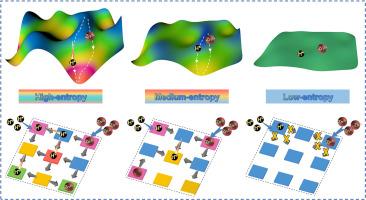基于梯度内建电场策略的高性能锌离子电池选择性质子加速通道
IF 20.2
1区 材料科学
Q1 CHEMISTRY, PHYSICAL
引用次数: 0
摘要
在锌离子电池中Zn2+与质子(H+)共包埋的储能机制中,具有最小摩尔质量和快速(非)配位动力学的H+显著减轻了结构应变,提高了循环稳定性。然而,现有的储存机制使质子的高比例储存受到限制。本文采用熵调制梯度内建电场策略构建选择性质子输运通道,并提供质子固定位点以增强质子储存。通过对不同熵值材料的实验和理论分析,论证了高熵材料独特的电荷特性导致材料内部的梯度内置电场形成连续的离子输运途径。与Zn2+相比,H+具有较高的电荷质量比和较低的输运能垒,使得离子在加速通道中输运更加连续和快速,从而选择性地调节H+输运动力学。此外,梯度内置电场的多个活性中心作为质子嵌入的固定化剂,显著提高了质子在材料中的结合能力。这些发现揭示了熵调节梯度内建电场机制在质子选择性存储中的重要作用,为高性能ZIBs的开发提供了新的参考。本文章由计算机程序翻译,如有差异,请以英文原文为准。

Selective Proton Acceleration Channel via Gradient Built-in Electric Field Strategy for High-performance Zinc-ion Batteries
In the emerging energy storage mechanism of Zn2+ and proton (H+) co-embedding in aqueous zinc ion batteries (ZIBs), H+ with minimal molar mass and fast (un)coordination kinetics significantly alleviate the structural strain to boost the cycling stability. Yet, existing storage mechanisms make the high percentage of proton storage limited. Here, an entropy-modulated gradient built-in electric field strategy is employed to construct selective proton transport channels and provide proton immobilization sites to enhance proton storage. Through experimental and theoretical analyses of materials with different entropy values, the unique charge characteristics of high-entropy materials resulting in the gradient built-in electric fields inside the materials to form a continuous ion transport pathway are demonstrated. Compared with Zn2+, H+ with high charge-to-mass ratio and low transport energy barrier enable more continuous and rapid ion transport in the accelerated channel to selectively modulate the H+ transport kinetics. Additionally, the multiple active centers of the gradient built-in electric field serve as immobilizers for proton embedding, which markedly enhances the binding capacity of protons in the material. These findings provide insight into the essential function of the entropy-regulated gradient built-in electric field mechanism for proton-selective storage, and provide a new reference for developing high-performance ZIBs.
求助全文
通过发布文献求助,成功后即可免费获取论文全文。
去求助
来源期刊

Energy Storage Materials
Materials Science-General Materials Science
CiteScore
33.00
自引率
5.90%
发文量
652
审稿时长
27 days
期刊介绍:
Energy Storage Materials is a global interdisciplinary journal dedicated to sharing scientific and technological advancements in materials and devices for advanced energy storage and related energy conversion, such as in metal-O2 batteries. The journal features comprehensive research articles, including full papers and short communications, as well as authoritative feature articles and reviews by leading experts in the field.
Energy Storage Materials covers a wide range of topics, including the synthesis, fabrication, structure, properties, performance, and technological applications of energy storage materials. Additionally, the journal explores strategies, policies, and developments in the field of energy storage materials and devices for sustainable energy.
Published papers are selected based on their scientific and technological significance, their ability to provide valuable new knowledge, and their relevance to the international research community.
 求助内容:
求助内容: 应助结果提醒方式:
应助结果提醒方式:


